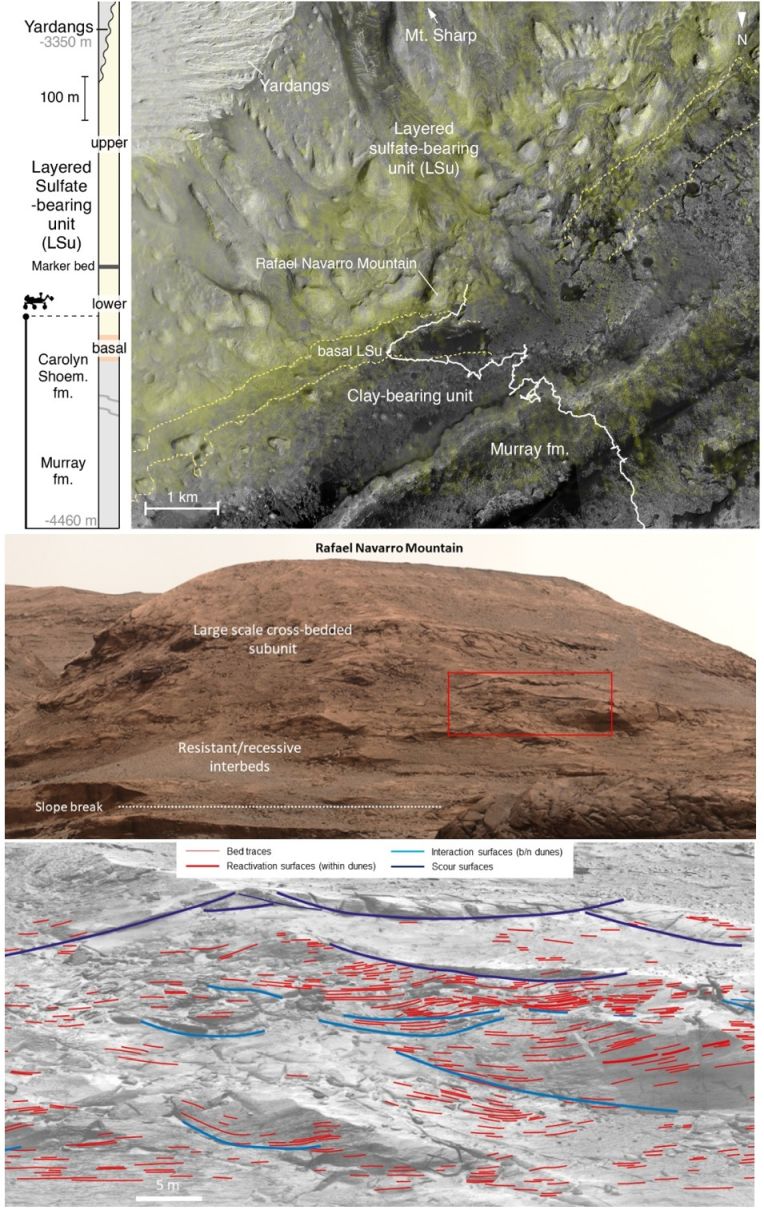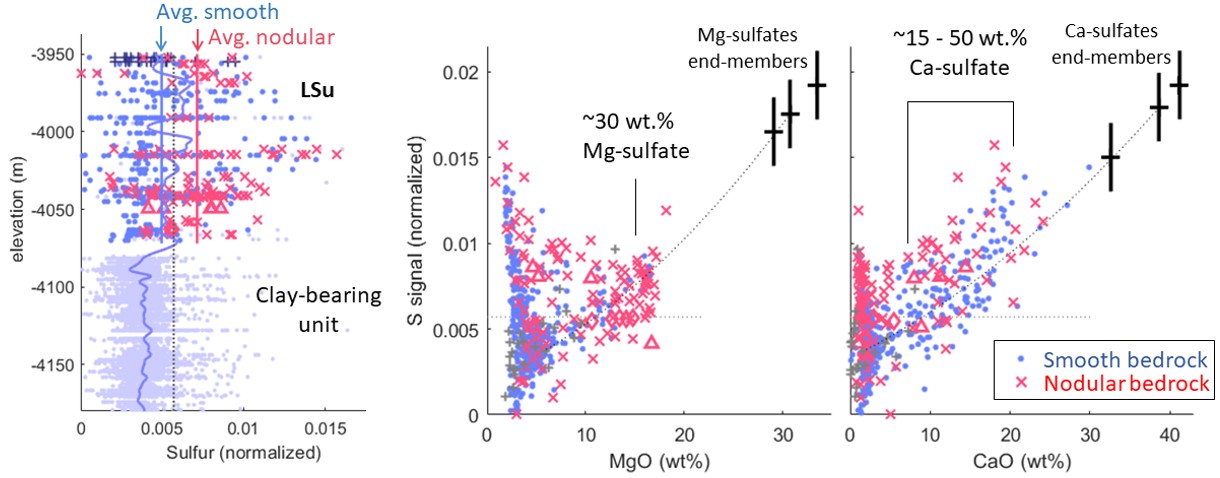- 1IRAP/UPS/CNRS, Toulouse, France (william.rapin@irap.omp.eu)
- 2JPL-Caltech, Pasadena CA, USA
- 3LGL-TPE, Univ. Lyon, Lyon, France
- 4DGS, Indiana Univ., Bloomington IN, USA
- 5Space Science Institute, Boulder CO, USA
- 6University of Tennessee, Knoxville TN, USA
- 7UC Santa Cruz, Santa Cruz CA, USA
- 8Caltech, Pasadena CA, USA
- 9Imperial College London, London, USA
- 10LPG, Nantes, France
- 11Jacobs-NASA JSC, Houston TX, USA
- 12UC Berkeley, Berkeley CA, USA
- 13LANL, Los Alamos NM, USA
- 14Purdue Univ, Lafayette IN, USA
On Mars, prominent thick-layered sulfate-bearing deposits are observed at a number of late Noachian to late Hesperian locations (~3.5 Ga) [1]. Their apparent absence in older strata has led to the hypothesis that they represent ancient evaporites related to the global aridification [2]. In Gale crater, the Curiosity rover is now exploring the Layered Sulfate-bearing unit (LSu), which is a hundreds of meters thick regional package of yet unknown origin within the Mt Sharp group (Fig. 1). Curiosity investigations can test whether its formation processes are similar to the Burns fm., another major sulfate-bearing strata documented by the Opportunity rover, or distinct such as a form of primary evaporites, syndiagenetic or later stage diagenetic precipitations with different aqueous conditions.
After exploring the mudstone-rich strata of the Murray and Carolyn Shoemaker fm. for about seven years, the Curiosity rover entered the LSu in 2021. Bedrock in the basal section is marked by diverse diagenetic overprints where sedimentary structures are less visible. In some places, laminated mudstones or siltsontes associated with concretions and with mm-scale nodular features may present similarities to evaporitic textures previously observed in the Murray formation [3]. Further up, the rover imaged butte-forming outcrops (Fig. 1) and revealed a ~100-m-thick interval with a transition into large-scale trough cross-bedded structures, the lithology, scale and thickness of which has never been observed before by the rover at such close range [4].
The base of the LSu succession is marked by a sharp increase in density of bedrock nodular textures. The rover analyzed the composition of two bedrock components: (i) a smooth host bedrock, which was drilled several times, revealing the disappearance of clay minerals in X-ray diffraction [5] – the evolved gas analyses also suggest Mg-sulfates and an isotopic change in sulfur compared to the clay-bearing unit below [6]; (ii) a nodular bedrock, which was not drilled due to its uneven surface, but shows diverse sulfate-enriched compositions as measured by ChemCam. Overall, the bulk bedrock (combining smooth and nodular) shows an increase in sulfate content relative to prior strata, nodular textures being a key component of that change (Fig. 2). Unusual lithologies have been observed in the basal LSu, including a regular pattern of polygonal ridges (Fig. 2), clearly crosscut by later stage fractures, pointing to multiple phases of diagenetic alteration. These sulfate-enriched polygonal ridges may represent the first evidence of a paleosol on Mars formed by sustained wet-dry cycles at the surface [7].
The LSu shows multiple signs of marked changes towards drier paleoenvironments in the sedimentary and geochemical record. Within the large-scale cross-bedded strata of most likely eolian origin sulfates in the LSu differs from the Burns fm. homogeneous enrichments as they occur in the form of diverse heterogeneities mostly related to nodular bedrock. Ongoing exploration could help test whether the drying-upward transition reflects internal basin controls on the evolution of ancient Gale lake or external, possibly global, climatic controls.
References: [1] Ehlmann B. L. and Edwards C. S. (2014) Annu. Rev. Earth Planet. Sci. 42, 291–315. [2] Bibring J.-P. et al. (2006) Science 312, 400–404. [3] Schieber et al. (2022) LPSC #1034. [4] Rapin W. et al. (2021) Geology 49, 842–846. [5] Rampe et al. (2022) LPSC #1532. [6] Clark et al. (2022) LPSC #1160. [7] Goehring L. et al. (2010) Soft Matter 6, 3562–3567.

Figure 1: Context of the Layered Sulfate-bearing unit (LSu) exploration by the Curiosity rover. Top to bottom: map with rover traverse and general stratigraphic column; architecture of deposits observed on Rafael Navarro Mountain outcrop; example RMI close-up (red) showing evidence of large-scale cross-bedded sedimentary structures with possible hierarchy of eolian surfaces.

Figure 2: Top Geochemical transition into the sulfate-bearing unit as recorded by the ChemCam instrument on bedrock with both host and nodular textures. From left to right: Normalized sulfur signal on bedrock targets with elevation within the clay-bearing unit, the LSu, blue line shows bedrock average (host and nodular) highlighting a significant change of bedrock sulfur composition associated with the nodular bedrock (red line average); Sulfur as function of MgO and CaO content highlights the presence of Mg and Ca-sulfates in bedrock.

Figure 3: Remarkable nodular bedrock in the basal LSu highlights the diversity of textures observed within a short stratigraphic range with distinct sulfate-enriched composition. Decimeter-sized concretions (a); dark-toned nodular beds (b); regular pattern of polygonal ridges (c).
How to cite: Rapin, W., Sheppard, R., Dromart, G., Schieber, J., Clark, B., Kah, L., Rubin, D., Ehlmann, B., Gupta, S., Caravaca, G., Mangold, N., Dehouck, E., Le Mouélic, S., Gasnault, O., Clark, J., Bryk, A., Dietrich, W., Lanza, N., and Wiens, R.: The Curiosity rover investigates an aridification sequence in the layered sulfate-bearing unit., Europlanet Science Congress 2022, Granada, Spain, 18–23 Sep 2022, EPSC2022-1112, https://doi.org/10.5194/epsc2022-1112, 2022.

